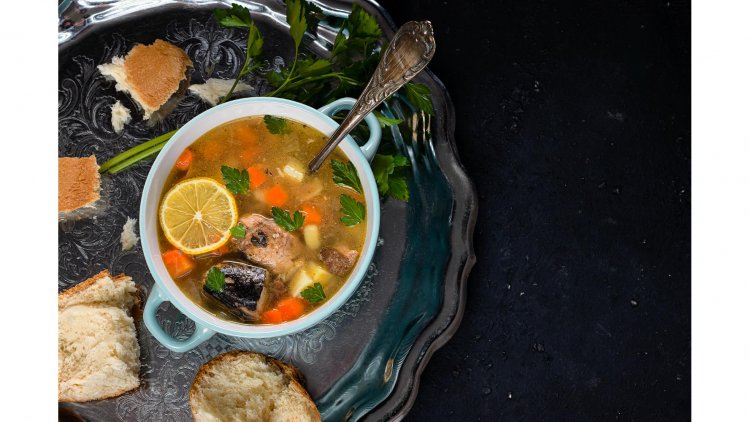A Taste of the Aegean: Dive Into Kakavia, Greece’s Legendary Fisherman’s Soup
Embark on a culinary journey to the sun-drenched shores of Greece with Kakavia, the traditional Fisherman’s Soup that’s as rich in history as it is in flavor. Originating from the islands and coastal towns where the daily catch was the cornerstone of survival, Kakavia is a timeless dish that celebrates the simplicity and freshness of the Mediterranean. This robust and hearty soup combines the freshest fish with ripe tomatoes, aromatic herbs, and a hint of lemon, offering a taste of Greek tradition in every spoonful.

The Ingredients: Freshness is Key
To make an authentic Kakavia, you’ll need:
- Fresh Fish: Aim for a variety of white fish such as cod, haddock, or sea bass. If possible, use fish that’s been caught the same day to ensure the best flavor and texture. You’ll need about 2 pounds of fish fillets, cut into chunks.
- Tomatoes: Fresh, ripe tomatoes are essential for the rich base of the soup. About 4 large tomatoes, peeled and chopped, will do the trick. If tomatoes are out of season, you can use canned tomatoes, but fresh is preferable.
- Onions and Garlic: One large onion and 3 cloves of garlic, finely chopped, will provide the aromatic foundation for the soup.
- Potatoes: For heartiness and to thicken the soup, peel and dice 2 medium potatoes.
- Carrots: Add 2 medium carrots, peeled and sliced, for a touch of sweetness and color.
- Olive Oil: Use 3 tablespoons of extra-virgin olive oil to sauté the vegetables and add a touch of Mediterranean richness.
- Herbs: Fresh dill and parsley are traditional. Use a handful of each, chopped. You can also include a bay leaf for extra depth of flavor.
- Lemon: The juice of one lemon will provide a tangy contrast to the rich broth.
- Salt and Pepper: Season to taste, but be generous to enhance the natural flavors.
- Water or Fish Stock: Use about 6 cups of water or homemade fish stock to create a flavorful broth.
Preparing the Soup: Step-by-Step
1. Sauté the Aromatics
Heat the olive oil in a large pot over medium heat. Add the chopped onion and garlic, and sauté until they are soft and translucent, about 5 minutes. This step is crucial for developing the flavor base of your soup.
2. Build the Broth
Add the diced potatoes and sliced carrots to the pot. Stir well to coat them in the olive oil and aromatics. Cook for an additional 5 minutes, allowing the vegetables to begin softening.
Pour in the water or fish stock and bring the mixture to a boil. Reduce the heat to a simmer, and let it cook for about 15 minutes, or until the potatoes and carrots are tender.
3. Add the Tomatoes and Herbs
Stir in the chopped tomatoes, bay leaf, and half of the fresh dill and parsley. Let the soup simmer for another 10 minutes, allowing the tomatoes to break down and meld with the other ingredients.
4. Incorporate the Fish
Add the fish chunks to the pot, gently stirring to distribute them evenly. Simmer for about 5-7 minutes, or until the fish is cooked through and flakes easily with a fork. Be careful not to overcook the fish, as it can become tough and dry.
5. Season and Finish
Remove the bay leaf and adjust the seasoning with salt and pepper to taste. Stir in the remaining dill and parsley, and squeeze in the lemon juice. The lemon juice will brighten up the soup and balance the flavors.
6. Serve and Enjoy
Ladle the soup into bowls and serve hot. You can accompany Kakavia with crusty bread or a side of olives for a complete Mediterranean experience.
A Culinary Treasure Awaits
Kakavia is more than just a soup; it’s a window into Greek culinary traditions and the bounty of the sea. Its hearty nature and complex flavors make it a perfect dish for any occasion, from a casual family meal to a festive gathering. By using fresh ingredients and following these steps, you’ll bring a touch of Greek coastal charm to your table.
Disclaimer
The recipes shared on this blog are intended for informational and entertainment purposes only. We do our best to ensure accuracy, but ingredient and preparation variations can alter results. Please use caution and consult a medical professional if you have dietary restrictions or health concerns. The blog and its authors are not liable for any adverse effects or consequences resulting from the use of the recipes provided. Always prioritize your health and safety when cooking.
What's Your Reaction?





















